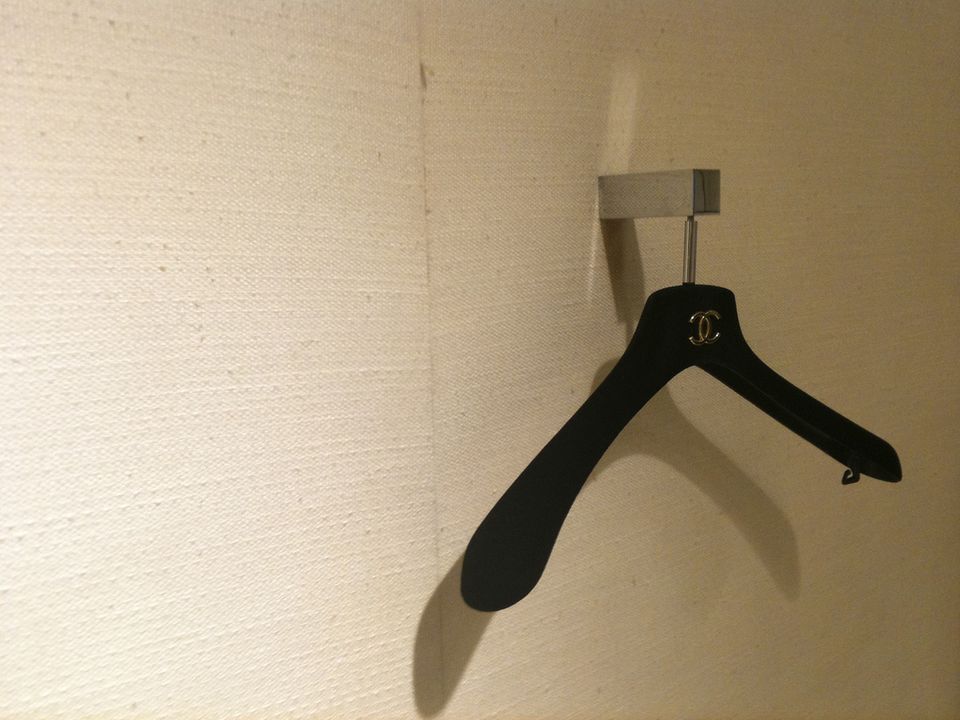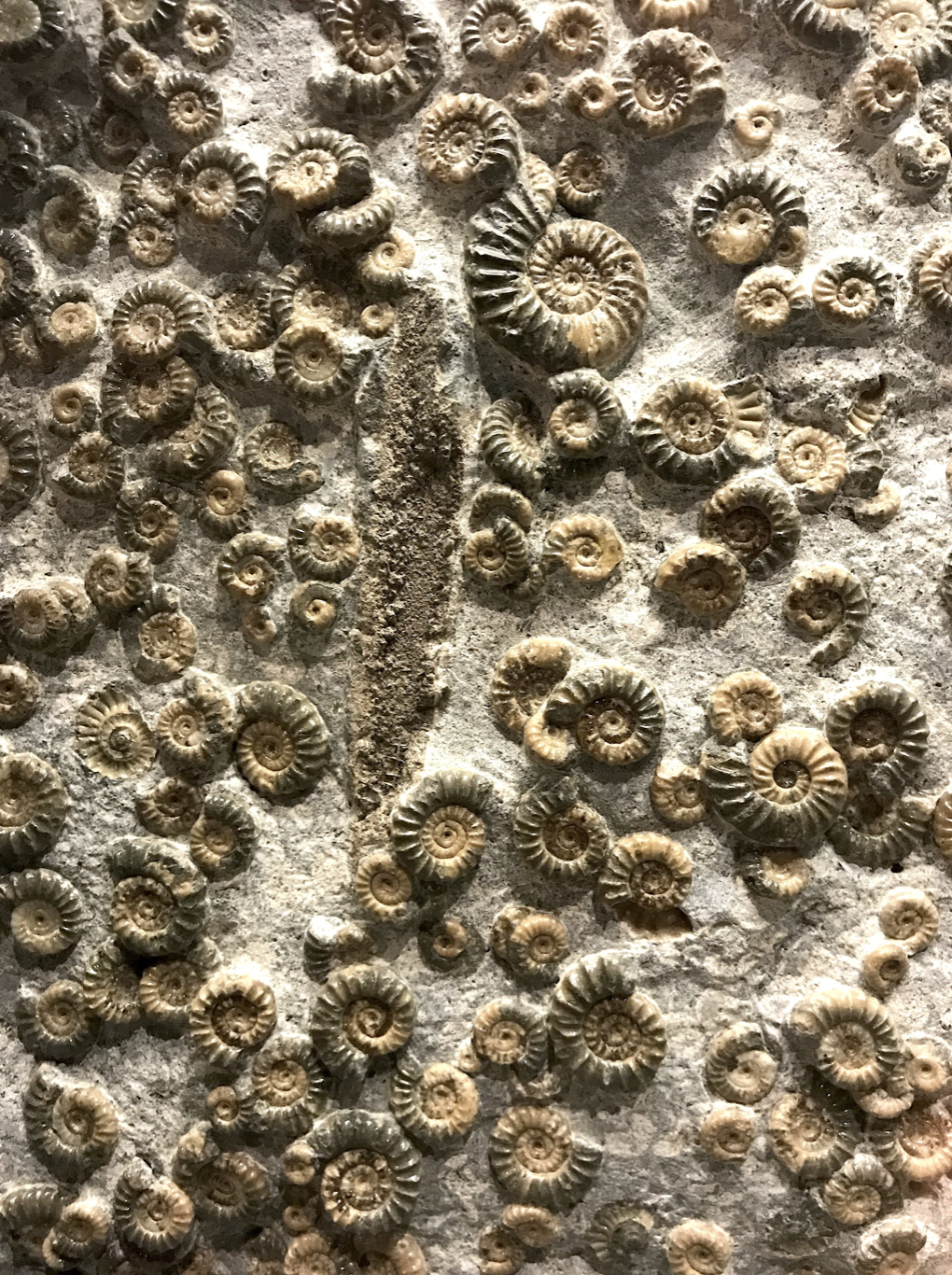I guessed who she was before I saw her wearing mimosa tweed. On my way up the stairs I looked and she was there, tall and blond. She smiled a slight, quick smile. Her face was avian. Her nose reminded me of Oriane Guermantes, and France was present in the drooping corners of her lips. It created an ambiguity from her smile not so much alluring as bashful. She wore a gray wool skirt with black leggings disappearing into slim, black leather boots. She wore a tiny belt with a shining buckle. A black satchel sat across her shoulders, over a long-sleeved, black shirt. The Neiman Marcus taxonomy put her clothes into the paradoxical category of designer sportswear. If modeling is a sport, these were her warm up sweats.
I spent the next hour forgetting our encounter. I boxed up the cosmetics: Bvlgari aftershave, Bobbi Brown lipstick, Dior bronzing spray. I was half asleep when the announcement for the morning meeting summoned me to the Chanel boutique on The Plaza.
The Plaza is Neiman’s bottom floor and devoted to women’s clothes. Its lighting is perfectly artificial and exposes every thread. Small squares emerge from the walls: glass partitions their congregations. The faithful would be mute except for the light that makes their fabric sing. The names are in silver above each boutique, chapels on The Plaza’s nave: Jil Sander, Georgio Armani, Armani Collezioni, Akris, Escada, Etro, Donna Karan, Loro Piana, Brunello Cucinelli, and Chanel. I walked to Chanel alongside sales associates clicking across the marble in heels and wooden soles. It made a sound like the release of a firing pin with no round to fire. Thirty games of Russian Roulette converging.
It was October, but Chanel had decided it was high summer on the French Riviera in 1950. The touring representative explained that the prêt-a-porter clothes and accessories were an intentional nostalgia for Rita Hayworth and her court. I heard the click of heels and looked up.
Instead of the black and gray, she wore a yellow jacket, white underpinning and skirt. We were informed the yellow was, in fact, mimosa. The jacket sat perfectly on her slim shoulders, and its sleeves tapered down her arms toward a chic revelation of wrist. The skirt reached past her knees while accentuating her hips. Somehow it had more to do with geometry than sensuality. She smiled the slight smile. I was beginning to understand that clothing can be realized, finished art only when it is worn.
The representative announced that Chanel burns its tweed patterns every year in order to force the creative effort of the next. She also wore Chanel. Her leggings were a second, sheer black skin; let up and padded just enough in the front. I noticed this as she explained Mr. Lagerfeld’s belief that the shoulder is the sexiest part of a woman’s body. The low cut of her taut underpinning beneath the high cut of her knit blazer, whose edge grazed the curve of her round, sable rear indicated that such givens are not always free. In defiance of the revelations, the model’s bare shoulders and her careful, searching eyes remained transcendent. The quest for profit had turned, for a moment, into the discovery of a new world. The lecture from the old one resumed as soon as the model disappeared into the changing room.
“Can anyone tell me about the Promenade de Croisette?” the representative asked our little class.
The model returned. She wore a high-cut white, knit sweater left unbuttoned to show the black single piece bathing suit beneath it. Crystals glared in oblique patterns against it. She moved like a bird that thinks it is alone, with comfortable grace. I wanted to know what was shining through her, feel the supple reality of being the way I felt the black silk of the Balenciaga dresses I had packed that morning. We long for sense perception of the things we know to be outside the range of empirical experience. The representative made sure we knew the swimsuit was strictly for poolsides.
The model appeared for a third time. She wore a black and white evening gown. The white hugged her body, the black draped over it and fish tailed in the back: a dress within a dress. When she turned, the white plunged in a V. Her right shoulder blade had a small mole on it. As she walked back and forth, the sales associates applauded. She turned and walked into the dressing room. I never heard her speak. I had six hours of packaging clothes to consider what her performance might mean.
1. The genius of a designer lies in his ability to see the complete word he is building. He is like a painter, but a painter only needs his model once for a portrait. Without the constant intercession of a body, a word communicating its idea or at least as much of it as possible, clothing is only pieces of fabric. I realized what silhouette means to fashion. Without her, the gown was inanimate, expensive fabric. It made no difference whether it was rolled, folded, piled, or hung, but on this woman it became art. It takes humanity to give form to clothes before they can give any definition to humanity.
2. On the runway haute couture nears pure form, and pure form always requires sacrifice. The most recognizable is that the clothes are not usually functional and rarely look comfortable. But that realization leads to the deeper question of what the model needs to do in order to make the clothes beautiful. Hence the intercession: the model must be mute and her perfect movements must speak for her, the designer, and the pieces. She cannot speak for herself. The sacrifice is to conformity for the sake of a novelty that, in the best cases, leads to beauty. The models must present similar silhouettes; they must be uniform in order for the designs to have their effect. Form gives birth to beauty, which in turn gives birth to form. I realized that just as a text must be subject to grammar and word placement before it can become a poem, fashion requires submission to rules.
3. Fashion, as text, can never separate itself from its model just as poetry requires a reader, and a score requires an orchestra. To experience fashion as text, we have to see it worn, whereas, with a poem, we can read it to ourselves without the poet present. Full perception of a silhouette never permits us to be the designer or the model in the same way a poem opens itself up to interpretations. A designer deploying models is choosing and placing single words with strict referents. To best perceive the piece requires seeing it modeled. Our motives and perceptions are never pure enough when we are dressing ourselves.
4. I was after both physical presence and form, i.e. an ideal of beauty to be communicated in reality. My anti-realism restricted her to being a text. My idealism required her to be a concept. I needed her to be both, and I wanted proof. But what is beauty in a game that most of us regard as sexual or power driven? I conceived of it as an ethical category: loyalty to a set of common perceptions that requires a sacrifice of models before iPhones and cameras. Mute flesh and blood silhouettes marching away from themselves toward a form that eludes them precisely because it is pursuing an individual beauty in the varied pieces each unique body has created. Each model in her gown is the best word the designer can find for the poem he is trying to create. But each model cannot help being a poem in herself.
5. Of course, it may be that the only general ethic involved is the fear of breaking laws about indecent exposure while getting as close as possible. Any true deconstructionist would have to advocate nudity. Then suicide. I thought briefly of Alexander McQueen. Fashion so quickly dissipates into cycles of kitsch and money. I felt guilty looking for transcendence in a sales pitch.
6. Here was another problem. Can the model take the silhouette to a place beyond commodity? Fashion off the rack is expensive reification; but humanity, no matter how muted, is not a thing. A salesperson might define a human being as a thing to be clothed and nothing else. But fashion, in quest of beauty, especially if it is original, cannot afford to bypass actual humanity. At its best, it acknowledges the place where clothes, physical presence and personality are indistinguishable. The price tag is meaningless because such interplay is beyond material wealth. And it starts to become play instead of poetry the moment money is involved. The beauty of even our daily wear is measured by the degree to which we can sacrifice our personal desire for money, sex, and power and still maintain conformity with form, our body, as an expression of originality.




